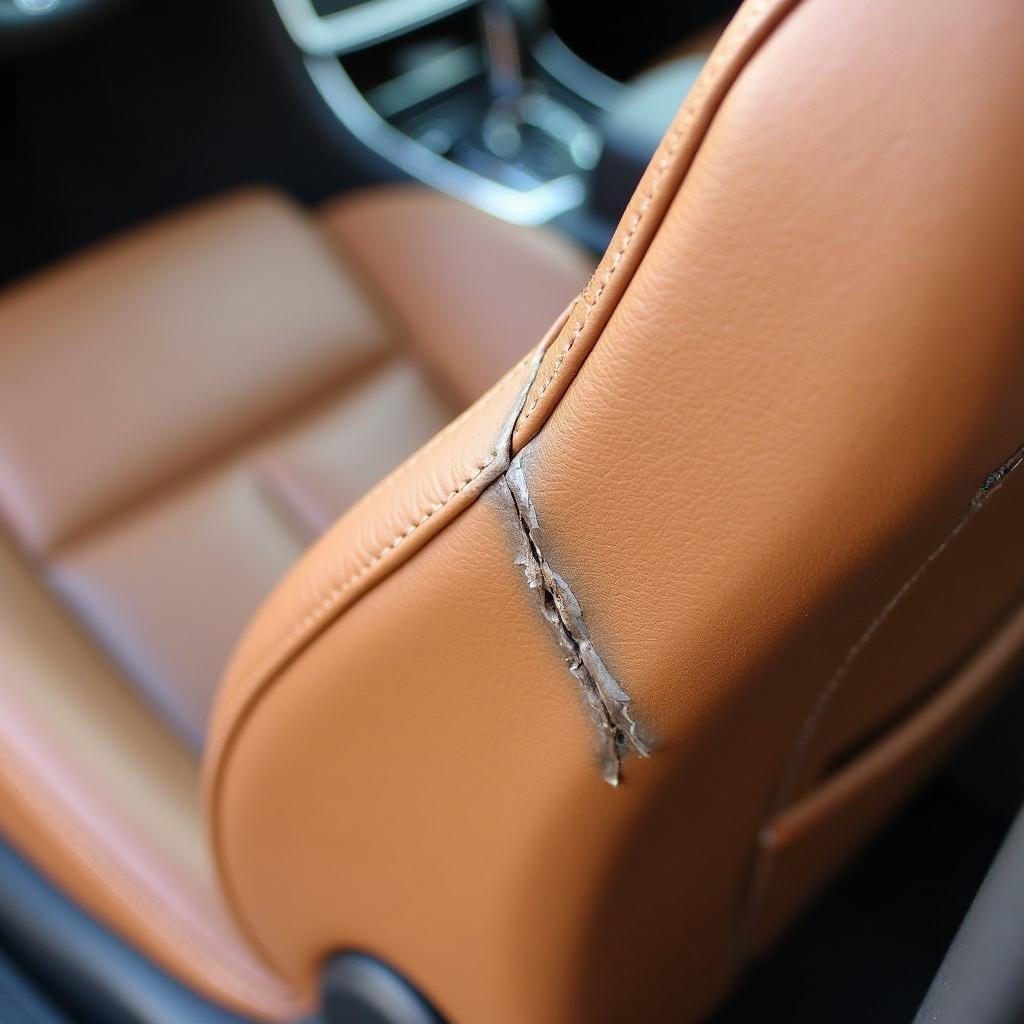Discovering a tear in your Mercedes-Benz car seat can be disheartening. Those luxurious interiors deserve the best care! But before you panic, remember that a tear doesn’t have to mean a complete seat replacement. With the right approach and a little know-how, you can often repair the damage yourself and restore your MB’s interior to its former glory. This comprehensive guide will walk you through the steps to effectively repair a tear in your MB car seat, saving you money and preserving the value of your vehicle.
Assessing the Damage: Fabric vs. Leather
The first step is to assess the severity and type of tear you’re dealing with. Is it a small cut, a rip along a seam, or a large gash? Is your seat upholstered in leather or fabric?
- Fabric Upholstery: Tears in fabric car seats are often addressed with patching techniques or liquid leather vinyl repair kits. These kits can be surprisingly effective for minor to moderate damage, blending the repair seamlessly with the existing fabric.
- Leather Upholstery: Leather repairs require a slightly different approach. Small tears can often be addressed with leather filler and adhesive, while larger tears may require a patch or professional attention.
DIY Repair or Professional Help?
Before diving into DIY solutions, it’s crucial to determine if the tear is something you can tackle yourself or if professional help is needed.
Consider DIY Repair If:
- The tear is small and superficial.
- You’re comfortable with basic repair techniques.
- You want a cost-effective solution.
Seek Professional Help If:
- The tear is large or complex (e.g., involving multiple layers or seat mechanisms).
- The tear is in a highly visible area.
- You’re unsure about your repair skills.
can you repair car fabric upholstery seats yourself
Tools and Materials for DIY Repair
If you’ve determined that a DIY repair is the way to go, gather the necessary tools and materials. The specific items will vary depending on the repair method you choose (patching, liquid leather vinyl, etc.), but common essentials include:
- Cleaning Supplies: Isopropyl alcohol, microfiber cloth
- Scissors
- Tweezers
- Leather Repair Kit (for leather seats)
- Fabric Repair Kit (for fabric seats)
- Sub-Patch Material (for larger tears)
Step-by-Step Guide to Repairing a Tear in Your MB Car Seat
Here’s a general guide to repairing a tear using a leather repair kit. Always refer to the specific instructions provided with your chosen kit.
-
Clean the Area: Thoroughly clean the damaged area and surrounding upholstery with isopropyl alcohol and a microfiber cloth. Allow it to dry completely.
-
Prepare the Repair Compound: Following the kit’s instructions, mix the appropriate color of leather repair compound to match your car seat.
-
Apply the Compound: Carefully apply the compound to the tear, using a spatula to work it into the crevices and create a smooth surface. If using a sub-patch, apply it to the underside of the tear before applying the compound.
-
Create the Texture: If your leather seat has a textured surface, use the provided grain paper to imprint a matching texture onto the wet repair compound.
-
Drying and Curing: Allow the repair compound to dry and cure completely according to the manufacturer’s instructions. This may take several hours or even overnight.
-
Final Touches: Once the compound is fully cured, you can use a leather conditioner to blend the repaired area with the surrounding leather and restore its natural sheen.
Tips for a Seamless Repair
- Work in a Well-Ventilated Area: Most leather and fabric repair kits emit fumes, so work in a well-ventilated area or outdoors.
- Test in an Inconspicuous Area: Before applying any repair compound to the visible tear, test it in an inconspicuous area of your car seat to ensure color matching and adhesion.
- Less is More: When applying repair compound, it’s best to start with a small amount and build up layers as needed. This will help prevent a bulky or uneven finish.
- Be Patient: Allow ample drying time between each step of the repair process for optimal results.
Preventing Future Tears
Once you’ve successfully repaired the tear in your MB car seat, take steps to prevent future damage.
- Use Seat Covers: Consider using seat covers, especially if you frequently transport pets, children, or cargo.
- Be Mindful of Sharp Objects: Avoid placing sharp objects on your seats, such as tools, boxes, or even keychains that could snag the fabric.
- Regular Cleaning and Conditioning: Regular cleaning and conditioning will help keep your leather seats supple and less prone to tearing.
“Regular upkeep can make a world of difference,” says John Smith, a veteran auto upholstery specialist with over 20 years of experience. “A little care and attention can prevent many common car seat issues, including tears, fading, and cracking.”
By following these tips, you can prolong the life of your MB’s interior and ensure that it continues to provide you with the comfort and luxury you deserve.
Conclusion
Repairing a tear in your MB car seat might seem daunting at first, but with the right information and a bit of effort, you can achieve professional-looking results without breaking the bank. By following the steps outlined in this guide, you can restore your car’s interior to its former glory and enjoy many more miles of comfortable driving.
Remember, if you’re ever in doubt about your ability to repair a tear, it’s always best to consult with a professional upholstery specialist. They have the expertise and tools to handle complex repairs and ensure a flawless finish.
FAQs
Q: Can I use superglue to fix a tear in my car seat?
A: While superglue might seem like a quick fix, it’s not recommended for car seat repairs. Superglue can create a stiff, inflexible bond that will likely crack and peel over time, especially with the constant flexing and movement of a car seat.
Q: How much does it cost to have a car seat professionally repaired?
A: The cost of professional car seat repair varies depending on the severity of the damage, the type of material, and the location. Minor repairs can range from $50 to $150, while more extensive repairs involving large tears or seam replacements can cost several hundred dollars or more.
Q: Can I reupholster my car seat myself?
A: Reupholstering a car seat is a complex and labor-intensive task that requires specialized skills and tools. While it’s possible to do it yourself, it’s generally recommended to leave this job to experienced professionals to ensure a high-quality and long-lasting result.
Q: How can I prevent my car seats from fading in the sun?
A: To protect your car seats from sun damage, park your car in the shade whenever possible, use a windshield sunshade when parked, and treat your leather seats with a UV-protectant conditioner.
Q: How often should I clean and condition my leather car seats?
A: It’s generally recommended to clean and condition your leather car seats every three months or as needed, depending on usage and exposure to elements like sunlight and heat.
[how to repair a cut in cloth car seat](https://carrepairon.com/how to repair a cut in cloth car seat/)
Do you need help with your Mercedes-Benz?
Contact us on WhatsApp: +1(641)206-8880, Email: [email protected]. Our team of Mercedes-Benz specialists is available 24/7 to help.



